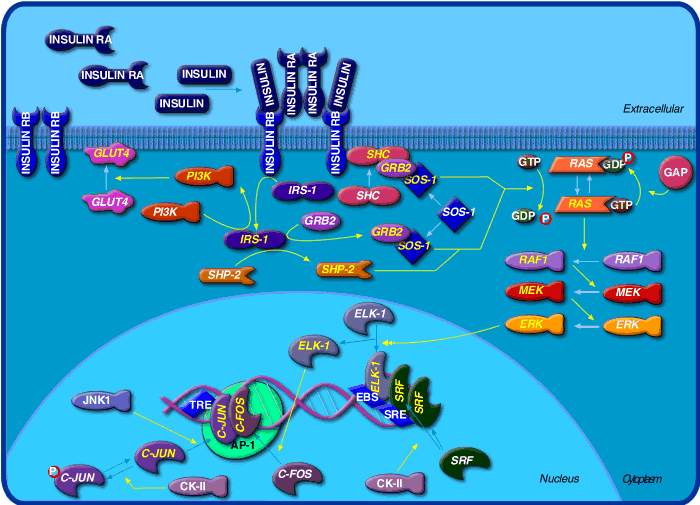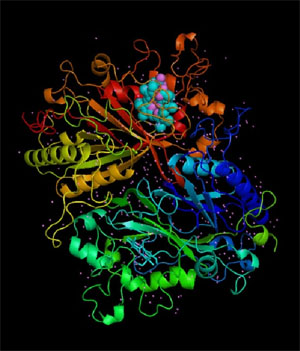5 Things Biologists Need To Learn When Presenting To Physicists
I don't know if you know this or not, but MBP has a problem. A *serious* problem: physicists despise going to biology talks and biologists despise going to physics talks and this can't go on.
The overwhelming dread I feel for at least 30 minutes every Tuesday/Wednesday afternoon (and for nearly 2/3 of Geneva Park talks) is not only unhealthy but also completely unsustainable. No one should have to feel like all of the air out of the seminar room is slowly being evacuated.
I am well-aware that there are plenty of problems with the way physicists approach biology audiences - those problems will be addressed in an upcoming post on this site... but for now, let's focus on the problem from one side to start the dialogue.
*Disclaimer*: My goal in penning this post is not to make incendiary or controversial remarks for the sake of attention nor is it to offend anyone. I am genuinely interested in increasing the quality of interaction between biologists and physicists in this department because it is sorely lacking. Take my remarks below with a grain of salt, they are simply my (strong) opinions on the matter. If your goal is to improve your grade in the seminar course, talk to the course coordinators. However if your goal is to deliver your message to the audience *AND* have them understand and appreciate it, read on. In my opinion, getting a better grade and having your audience appreciate your work should not be mutually exclusive, but I'm certainly not qualified to make that assertion.
Let's get right down to it:
1. Perspective, big picture and a core idea
When you design your presentation, you need to have in mind a core idea; something so fundamental that everything you say during your talk on some level relates back to this core idea and key message. Remember it, don't lose sight of it and repeat it back to the audience, they will be grateful for it. Make sure this core idea is basic and memorable. This is hard. Keep at it, you're smart, you'll figure out what the core idea needs to be for your presentation to come together.
With this core idea in mind, you can tell the audience how your core idea fits in to the grand scheme of things, Provide us with some perspective, a review of what is known and why your work is important. This is very critical, as without context, perspective and the big picture, your talk doesn't hold much weight in our eyes. You could be pushing the frontiers of science and we'd simply never know it because you never TOLD us!
The big picture is important but let's be honest, how often have we lost sight of it? How often do we think that the research we're doing is the be-all and end-all of all research? How often are we so passionate about our own research that our desire to show off the latest and greatest data overwhelms our sensibilities and prevents us from communicating the essence of our research to a non-technical audience. Remember what one of the speakers said at Geneva Park, "Data is sedative".
This is simply a microcosm of a larger problem - the disjoint between the scientific community and society has grown so large that we no longer bother with the struggle of educating the lay: we have problems educating each other. This is unacceptable and we need to fix it.
2. Know your Audience
I'm sure you've heard this many times over - it's at the crux of every good set of guidelines on how to give a talk. It's difficult to know your audience without knowing their background. In the case of MBP, it's even more difficult to assess because of the diverse nature of our prior education. A good rule of thumb here is to design your talk so it's understandable by most first year MSc. students in the physics stream and if you're a really senior PhD student, maybe you can increase the complexity of it to the level of a second year MSc. student in the physics stream. What does this mean? Well, a first year student in the physics stream will either be enrolled in or have completed the "Biology for the Physical Scientist" course. This course is roughly equivalent to 2nd year undergraduate cellular biology sprinkled with a little bit of biochemistry and genetics. That's it. Use that as your benchmark for what people know and you'll be served well.
Use your seminars to TEACH us, not just to show your data. Other than going and reading a bunch of textbooks, you are our only source of biology in this department. You are vital to keeping our research relevant and we need you to take responsibility for your role. Below I've given two examples of what happens when the background knowledge of your audience is overestimated.
3a) Complex pathways? (kiss of death)
Let me tell you something about pathways. Pathways are awesome. Pathways impress me immensely. Pathways take time to digest and fully appreciate. Pathways require a lot of background knowledge.
Pathways do not belong in 20 minute talks directed at an audience outside your field.
Pathways also do not belong in the introduction of a topic and pathways certainly do not belong in the first slide following your title.
If you show a complex pathway in your talk and gloss over the details, you've lost. You've lost the audience and you've lost the opportunity to present your hard-earned work. But the losses don't end there, the audience has also lost. We lose the opportunity to get engaged in your exciting work and ask meaningful questions. Instead, we negatively judge your talk by its least critical aspect, pull out our smart phones and check our emails.
I know pathways are critical for a lot of the talks, but delay the onset of lost attention as much as possible. You will lose a lot of people when you show complex pathways, it's absolutely inevitable. There is not enough time in a typical seminar talk to go over all the details of a pathway that many biologists know by heart and most physicists struggle at remembering just the abbreviations.
Here's a radical suggestion of what you can do - present your talk without showing the pathway at all ! It's possible, I assure you. All you need to do is to say a few key phrases that directly relate to your key message. Tell me which pathway this protein is involved in, what the significance of the pathway is and then give me a few key schematics showing what happens (in the grand scheme of things) when the protein is activated or de-activated. That's *it*. That's all that is usually required to keep our attention focused on the big picture and that should be all that you need to tell us in order to present your story.
Try it !
3b) Pretty 3D protein structures? (unnecessary)
Here is a good rule of thumb when dealing with graphics in your presentation: "If it is not absolutely essential to the core message you are trying to deliver, it does not belong and is effectively filler."
Let me try and stress what I mean precisely by "absolutely essential". Every single sentence that you utter in your talk, every single piece of text you have on your slide and every single image you show must be directly related to your core message. Not just that, but every piece of text and every single image should stand alone, independent of your presence in the room. Your slides should tell a story and your words should tell a story. That story must be the same. The only way it can be the same, is if they tell the same story independent of each other. By that I mean: we shouldn't need your slides to tell your story and your slides shouldn't need you to tell your story.
Now, in context of that, let's consider the 3D structures of proteins that have been showing up in slides. Are they really necessary ? How do they help you tell the story? Are you showing the 3D structure to make a point or are they there to add colour and visual effects to your slides? You can describe the protein domains all you want by pointing at the 3D structure, we won't see what you mean. I propose tha you can do the same thing with a crystal clear 2D schematic that is properly labeled. I can't look at a ribbon structure and make heads or tails of it - and more importantly, I don't think I need to. I maintain that a 3D model of a protein is appropriate in very few situations.
Take home message: Your message is key. Stay on message, avoid distractors, don't try and fool your audience with fancy images that don't add anything to your talk.
4. Process your raw data and present it in a digestible way
This one is going to be controversial but I've thought about it a lot and I have the courage of conviction to get right out and say it: the way biologists show raw data (for e.g., Western Blots) is completely silly.
At least that's what it seems for people that don't see them every day and hopefully I can demonstrate this cogently. Starting with the facts:
- - Most biologists can look at an image of a Western Blot or an Electrophoresis gel and instantly glean the correct information from it- Most physicists can't- Most biologists don't even need to think about how a Western Blot image is generated, they just need to look at the final result- Most physicists need to recall what a Western Blot is, try and remember how the blot works then try to decipher the tiny labels and visually re-orient the blot to match the image they have in their minds and then finally, try and make sense of the data. By this time, either we've already forgotten what was being measured or, the slide has been advanced.
Not cool! I *want* to understand your data! Take the time to present it properly. And by "properly" I don't mean the way you would present it to your lab or your supervisor. I mean the way you should present it to people that don't do what you do everyday. Respect your audience, show them the courtesy of processing your data in a more digestible way.
I don't mean to pick on just Western Blots, this applies to those that copy and paste non-sensical plots from their FACS software GUIs, show blurry pictures of electrophoresis gels, display garbage spectra from a mass spectrometer and the absolute WORST offenders: those that flash gene sequencer plots and expect people to see anything other than abstract art.
Wise up folks! Most of us are not as fast as you at looking at your data and understand what's going on... that's one reason why students rarely ask questions.
Here's how you can fix it: Take your plot, extract the information, estimate the uncertainty and then use your imagination and creativity to present the data sensibly (including uncertainty). For example, let's say you took 10 proteins and ran them through a gel across a voltage drop (electrophoresis). You discover that 3 of the 10 proteins are about the same size and the other 7 show a spectrum of sizes. Is it really that hard to read off the sizes in kDa and plot it in a bar graph? Is it essential to your talk that you show a picture of the gel or is it more important to figure out which protein is bigger and which is smaller? Are you afraid we won't believe you when you show the graph and say that you performed electrophoresis?
Science takes work, don't be lazy.
Note: If you read carefully, nowhere did I say that you should "dumb-down" your science to show it to physicists. Please, I cannot re-iterate this enough: I am not asking you to dumb-down your presentation. I am asking you to eliminate the distractors (you may not even recognize them as such) and focus on what's important: what your data suggests.
Take this (and the next point) to heart, if nothing else.
5. Make us care.
This is the single most important piece of advice I have to give. Even if I don't understand what you did or how you did it, from your presentation I should be able to extract at least *why* you did it. Frankly speaking, a small fraction of the biology presentations I've seen in the past 18 months have accomplished this. From the outset of your talk, you should specify clearly what the biological question is - using language that a non-technical audience can grasp and then move into why your research is important.
Your presentation is worthless to me if it is not immediately clear why you are doing what you're doing. This is the fundamental criterion a lot of people seem to blatantly ignore when speaking to an audience not in their field. If you're investigating p53 expression and regulation, is it not important to introduce how important this protein is? It is completely irrelevant that everyone on your floor at OCI and their grandmother is working on p53 - tell me AGAIN why it's important. Then tell me what aspect of this protein and its function you're seeking to exploit. Then tell me to what end. Then, and only then, do you have the right to tell me, and have me care, how.
Conclusions and a bold claim
It's hard to design a presentation for as many audiences as we need to in MBP. But it certainly is not impossible to do if we open the lines of communication between biologists and physicists. Physicists need to know how they can communicate their projects better to biologists and I wrote this post hoping the reverse is also true. Constructive criticism is important and I really think that with a concerted effort, we can work together and make it happen. I'll go right out and say that if biologists have any trouble hearing from physicists, please let us know. We want you to care about what we do and that will only be accomplished if we address whatever pet peeves you have about our presentations.
Let me end with a bold claim:
My claim is that *any* biology presentation can be adjusted to make it accessible to a physics audience.
I can guarantee it, and I'll even put my money where my mouth is. If anyone has a presentation that they think *cannot* be adjusted so that physicists will find it accessible and interesting, send it to me. I'll work with you to see how close we can get. I'll happily post a retraction if indeed we find that it cannot be done.
Thanks for reading, please comment below!
Cheers...
Firas





